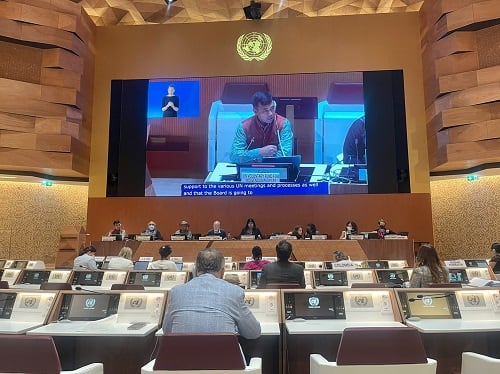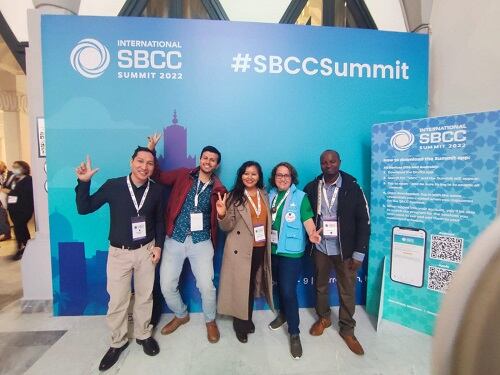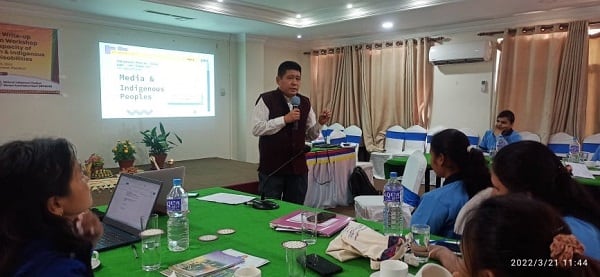The founder of Indigenous Television, Dev Kumar Sunuwar, is glad the station was able to get an operating licence under that name.
“If someone runs a generic search for indigenous television, this station operating out of Nepal pops up,” he says. “It gives us visibility.”
Indigenous Television started broadcasting in 2016 on World Indigenous Day, June 6. It was started by a team of journalists who were working in various media organisations in Nepal, where media content is predominantly in the Nepali language.
The initiative grew out of disillusionment with the media, says Sunuwar. Some 36% of Nepal’s population is Adivasi /Janjati (original inhabitants/ Indigenous peoples). But their issues, their traditions and their biggest events would always be pushed to a blurb in the corner of an inside page of national dailies, he says.
Of Nepal’s 123 recognised languages, 117 are spoken by indigenous peoples. These languages found no place in the mainstream media. Almost 60 of them are classified as endangered or vulnerable.

Indigenous Television founder Dev Kumar Sunuwar at the UN Voluntary Fund for Indigenous Peoples. Photo: supplied
“Twelve to 13 languages have disappeared in the last decade alone,” says editor-in-chief Kumar Yatru. “We started this station to give space to these (indigenous) languages and to allow for their intergenerational transmission”
From radio to television
Indigenous Television’s story is a long one, Sunuwar says. Its team of seven to eight were all from different indigenous communities, speaking different languages.
The indigenous movement was strong at the time the constitution was being drafted by the Constituent Assembly (formed in 2008).
Nepal’s FM revolution had given rise to many community-run radio stations, and the team toyed with the idea of starting a radio station in and around Kathmandu. But FM has limited reach, and the communities it wanted to target lived and spoke their languages in far-flung regions outside of the capital. In 2011, Indigenous Media Foundation was established and the organisation started a radio station in Ramechhap (an eastern hill district) broadcasting in the Sunuwar, Tamang and Sherpa languages. Their programmes were an instant hit, and feedback from their listeners (including online) was overwhelming.
“This was a time when people from the villages had just started migrating to the Gulf countries to work,” says Mayalu Ngyasur, a Tamang language presenter, who started her journey in radio before moving to television. “Along with letters and requests, people would send us money in envelopes,” she says.

The satisfaction of working in one’s own language is a feeling “I cannot put into words,” says Mayalu Ngyasur (centre) who presents shows in her native Tamang language.
Ngyasur had worked in Kathmandu in Nepali language media. “But the satisfaction we get from working with our own language is something else,” she says.
But radio content is ephemeral, says Sunuwar, whereas TV content is archived. The team decided to take the plunge into television. It took half a decade of lobbying to finally get the licence to operate as “Indigenous Television.”
Challenges and blessings
Funding was always going to be a challenge, managing director Jagat Lama Dong says. “The other challenge is fighting preconceived notions. When people hear Indigenous Television, they think we are being communal and catering to groups,” he says.
Nothing could be farther from the truth, he says. “We always believed the media wasn’t proportionally representative in the way our parliament aspires to be. The diversity we want in our politics should also extend to the media. We try and give space to everyone,” he says.

“In a diverse country like Nepal, only one language was finding a place in journalism,” editor-in-chief Kumar Yatru. says Photo: Supplied
The channel broadcasts programmes in 17 indigenous languages, alongside Nepali and English.
“We would like to create content in more languages,” says Kumar Yatru, “but we have to deal with a shortage of manpower while working in the media sector.”
“We are creating space for minorities, for madhesis (people in the southern plains), for Muslims, and for those who identify as LGBTQ,” says Dev Kumar Sunuwar. “Primarily anyone who wouldn’t otherwise find a voice in mainstream media. If you look at it that way, then we aren’t just catering to the 36% indigenous, but more than 70%,” he says.
Sunuwar believes a lot has gone right for Indigenous Television. “UNESCO made us an official media partner, and we get a warm reception at all international forums,” he says. “Even Covid-19 was a blessing. We started making PSAs in different languages, and that made international organisations and the government realise that this was something they needed to do all along,” he says.
A sense of pride
Mayalu Ngyasur’s desire to create content in her Tamang language arose from her personal experience. “When I first came to study and live in Bhaktapur (a city which,, along with Lalitpur and Kathmandu makes up the Kathmandu valley), the locals regarded us with suspicion when we spoke our language. The discrimination was palpable,” she says.
“It is no longer like that. People from different regions living in the valley speak their own languages without hesitation these days,” she says. “To an extent, we have normalised the use of our language in everyday life.”
“Many people had no reach in the media, and now those very faces are on TV, wearing their costumes, speaking their language, and that inspires an entire generation to think of media as a potential line of work,” says Sunuwar. He is glad young people are signing up to various media organisations around the country and sees a bright future.
“Nepal signed up to the UNDRIP and ILO 169 (Indigenous and Tribal People’s Convention 1989). So now, the state has to provide a curriculum in mother tongues, to create content in languages, even if it is just translations,” Sunuwar says.
For indigenous languages and Indigenous Television, he believes it is a good thing.
Lessons from Aotearoa
Nepal could learn from Kohanga Reo and Whakaata Māori in its journey of language revitalisation, says Sunuwar. “Before starting television, we looked at Māori Television extensively,” he says.
“I read reports saying Māori Television actually helped in the revitalisation, protection and preserving of Māori language, and we thought maybe we in Nepal can do the same thing.”
“And to some extent we are also following the same path, creating the same history,” he says.
Sunuwar believes the channel’s story can be an example to “indigenous brothers and sisters from around the globe.”
“If indigenous people from Nepal can do it, why not they, too?” he says.
Video journalist Rituraj Sapkota is travelling in South Asia and writing about conservation, sustainability and indigenous practices.

